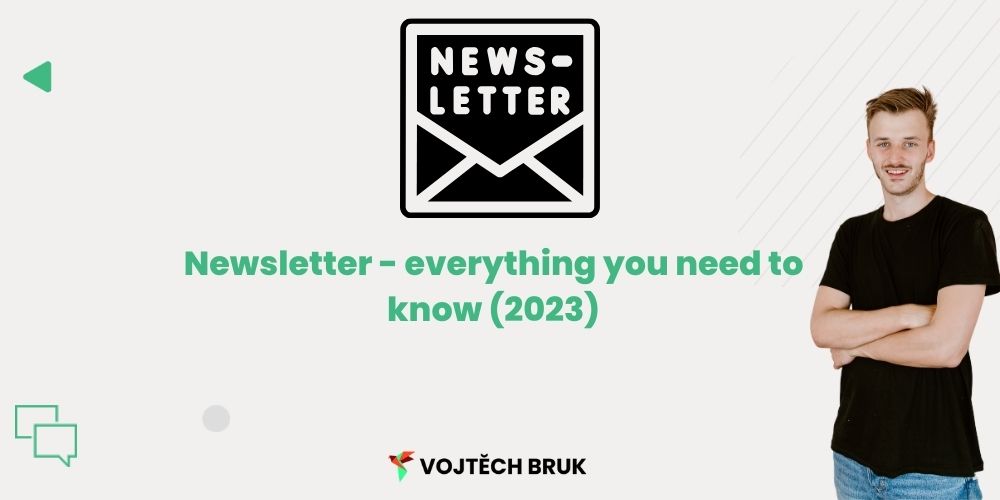This article tells you everything you need to know about the newsletter.
The newsletter is the most underrated marketing channel in my opinion. But you’ve probably already noticed that I’m an avid fan.
In this article, you’ll learn why.
What is a newsletter
A newsletter is written content that goes out on a regular basis to people who have subscribed to it.
Most of the time we associate the newsletter with the online world, however, it can also come physically (I actually get one in my mailbox).
This article will focus primarily on content newsletters (where creators create original content within the newsletter). I will leave aside purely promotional newsletters (sending discounts), as these are primarily the domain of email marketing.
So why bother with content newsletters at all?
Why write a newsletter
There are many reasons, let’s take a quick look at the three most compelling ones.
1. It’s yours
- Google changes algorithm,
- social networks will give you a shadow ban (your content will stop showing to your fans)
- Advertising will get cheaper and suddenly this feed won’t be profitable…
There’s a lot that can happen. And often you only affect your end of the transaction. Unfortunately.
Newsletter does it differently.
With a newsletter, you own the entire infrastructure. It’s yours, and as long as people want to read your news, they can.
2. Personalization and scalability in one
People are used to personal messages with email. Friends, colleagues, family… That’s why we check email all the time. And we know that people write to us.
It’s different on social media, it’s more of a fairground, where others are shouting at you, trying to get your attention.
The newsletter, on the other hand, is where we often give our attention.
At the same time, a newsletter is wonderfully scalable and whether you write a personal message to 15 people or 15,000 actually makes no difference.
3**. Čísla**
The email is said to have a ROI (return on investment) of about 36x.
Another often cited statistic is that every 1 (active) subscriber is worth approximately Even if the above mentioned numbers (ROI and subscriber value) seem inflated to you, try to see for yourself in your own newsletter! You might be surprised. P.S. The stats are, in my opinion, skewed by the fact that you can only invest in a newsletter up to a certain point. It is possible to invest 10 000 CZK, however you will not spend a million on a newsletter (unlike other forms of promotion). So while the ROI will be huge the ROC (return on capital) won’t be much. I believe newsletter is a great tool, but unless newsletter writing is your primary business, I would always supplement it with other activities. In addition to these three most compelling reasons, I mentioned a few more in my why write a newsletter article.However, there’s nothing like seeing for yourself. But do I have any personal experience with the newsletter at all, since I adore it so much here? I am close to newsletters and have always enjoyed them. Whether as a creator or a reader (that’s what I find important). For most personal projects I’ve ever had, I’ve also run a newsletter (and occasionally sold something through it, see above). If you’re still not convinced, that’s fine, however, I have nothing more to offer :D. Well, maybe you trust me a little though and would like to give the newsletter a chance. How do I get started? In this article, the best newsletter tools, I introduce a bunch of software that will make getting started easier and help you get started.I’ll just highlight the most important ones here: If you are interested in more options and tools, you will find a lot of useful information in the article mentioned above. Once you’ve decided to create and selected a platform, you’ll be faced with the next question: There are a lot of tactics and tips, let’s take a look at the 4 that have worked best for me. A lead magnet is a “gift” that you offer your potential subscribers for signing up for your newsletter. It can be Anything. It’s not about having the best lead magnet in the world. It may be worth investing a ridiculous amount of time in it, but in the beginning, it’s definitely true: any lead magnet no lead magnet. Take the help of Canva and you’re done in an afternoon. The sign-up page you subsequently promote is often the cornerstone of your newsletter’s (un)success. How to create such a page is discussed, for example, in the article How to make a landing page. However, you won’t go wrong even if you look at how the competition does it and try to creatively imitate their example. It’s then good to take inspiration from giant (if not industry-specific) newsletters abroad, which actually have an entire (giant) business based on similar sign-up pages. As humans, we love to test, measure, compare. We’re just like that. If you have even the slightest ability to provide any of this on the web, do it. You get the principle… You can show people the results and offer the option of sending additional content in the mail (correct answers, tips on how to improve to succeed in the test, etc.). You can also be less “friendly” and if people want to know the result, they have to enter the email you send it to. You’ll get more emails, but at the cost of annoying a lot of people (I don’t want to give an email and I’ve wasted 3 minutes filling out something I won’t know the result of) and a lot of addresses won’t be of very high quality. Anyway, I highly recommend giving the quiz tactic a try. You’ll be surprised how many answers (leads) you can get. For all email addresses that are relevant to tell people about the newsletter, add a link to sign up in your signature. It’s a small thing, but you write emails frequently, and once you create a signature, it’s a purely passive source of contacts. If you’re interested in other tips, I’ve expanded on the topic in the How to Get More Newsletter Subscribers article. The newsletter is worth a try. It’s low-cost, effective, and can be handled by one person just fine. Plus, it makes business sense too. But I don’t want to repeat myself. Try it. And let me know in the comments how you feel about it and what your experience with the newsletter has been?
My experience with the newsletter
Tools for the newsletter
How to get more subscribers to your newsletter
1. Create a lead magnet
2. Create a good conversion page and promote it
3****. Quizzes, Audits, Measurements****
4. Email footer
Useful Links
Word in conclusion





